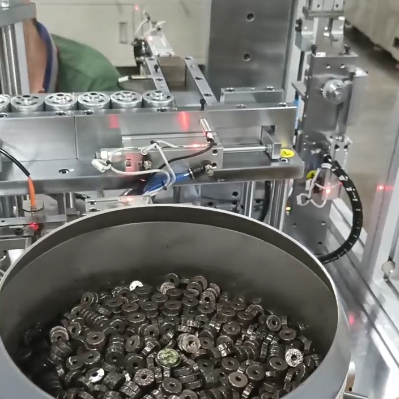What are the common sensor failures and their solutions for DC motor motor automatic bearing press fitting machine?
DC motor motor automatic bearing press fitting machine common sensor failures and solutions are as follows:
1, displacement sensor failure
Failure phenomenon:
The measured displacement value is inaccurate, and there is a deviation from the actual press fitting position, resulting in the bearing press fitting depth does not meet the requirements.
Sensor output signal is not stable, jumping or fluctuations, affecting the precise control of the press-fitting process.
No signal output from the sensor, the equipment can not obtain displacement information, resulting in the press-fitting work can not be carried out normally.
Cause analysis:
The sensor probe is worn or damaged, affecting the measurement accuracy.
The installation position of the sensor has changed, resulting in inaccurate measurement reference.
The connection line is loose, broken or short-circuited, which obstructs the signal transmission.
Dust, oil and other pollutants in the measurement environment adhere to the sensor probe, affecting the measurement accuracy.
Solution:
Regularly check the wear and tear of the sensor probe and replace the badly worn probe in time.
Recalibrate the installation position of the sensor to ensure that the installation accuracy meets the requirements.
Check the connection lines, repair loose connectors and replace damaged wires.
Clean the sensor probe to remove surface contaminants.

2, pressure sensor failure
Fault phenomenon:
The pressure measurement value does not match the actual pressure, resulting in too much or too little press force, affecting the bearing press quality.
Pressure sensor output signal abnormality, drift, fluctuation or sudden change and so on.
The sensor suddenly fails in the working process, and the pressure cannot be measured normally.
Cause analysis:
The elastic element of the pressure sensor is fatigued, deformed or damaged, affecting the measurement accuracy.
The calibration of the sensor is inaccurate, resulting in a large measurement error.
The pressure sensor is affected by factors such as shock, vibration or overload, and the internal circuit is damaged.
The temperature, humidity and other factors in the working environment vary greatly, causing the sensor performance to drift.
Solution:
Replace the damaged pressure sensor elastic element or the entire sensor.
Recalibrate the pressure sensor to ensure measurement accuracy.
Check the installation and fixation of the sensor and take shock absorption measures to avoid shock and vibration of the sensor.
Temperature compensation of the sensor or take thermostatic measures to reduce the impact of environmental factors on the performance of the sensor.
3, temperature sensor failure
Failure phenomenon:
The temperature measurement value is inaccurate and cannot truly reflect the operating temperature of the bearing or equipment.
Sensor output signal abnormality, a sudden increase or decrease in temperature value, fluctuations and so on.
Temperature sensor does not work, no temperature signal output.
Cause analysis:
The probe of the temperature sensor is aging, damaged or has poor contact, affecting the accuracy of temperature measurement.
Deviation in the calibration of the sensor, resulting in inaccurate measurement results.
Connection line failure, such as broken circuit, short circuit or poor contact, so that the temperature signal can not be transmitted normally.
Electromagnetic interference in the working environment, high temperature and other factors affect the normal operation of the sensor.
Solution:
Replace the aging or damaged temperature sensor probe and make sure that the probe is in good contact with the measured object.
Calibrate the temperature sensor and adjust the measurement accuracy.
Check the connection line, eliminate line faults, and ensure that the signal transmission is normal.
Take shielding measures to reduce electromagnetic interference, heat dissipation or insulation of the sensor to avoid high temperature effects.
4, photoelectric sensor failure
Failure phenomenon:
The photoelectric sensor is unable to accurately detect the position of the bearing or other parts, resulting in errors in press-fit operation.
The output signal of the sensor is unstable, and there is a false trigger or missed trigger.
The sensitivity of the photoelectric sensor is reduced, and the detection ability of the object is reduced.
Cause analysis:
The light-emitting element or light-receiving element of the sensor is damaged, affecting the emission and reception of the signal.
The optical path of the sensor is blocked or polluted, resulting in blocked signal transmission.
Dust, water vapor and other pollutants in the working environment affect the performance of the sensor.
The sensor is installed in an improper position, resulting in an inaccurate detection range.
Solution:
Replace the damaged light emitting element or light receiving element.
Clean the sensor's optical path to remove obstructions and contaminants.
Seal the sensor to protect it and reduce the impact of environmental contaminants.
Adjust the installation position and angle of the sensor to ensure accurate detection range.
5, proximity sensor failure
Failure phenomenon:
The proximity sensor is unable to detect the approaching object normally, resulting in the equipment not being able to accurately determine the position or status of the bearing.
The output signal of the sensor is unstable, and there is a case of misoperation or inactivity.
The detection distance of the sensor changes and does not match the actual set value.
Cause analysis:
The sensor head of the sensor is damaged or aging, affecting the sensing performance.
The working voltage of the sensor is unstable, resulting in abnormal output signals.
Metal objects in the surrounding environment, electromagnetic interference and other factors affect the normal operation of the sensor.
The installation gap of the sensor is too large or too small, affecting the detection accuracy.
Solution:
Replace the aging or damaged sensor head.
Check the working voltage of the sensor to ensure that the voltage is stable.
Take shielding measures to reduce electromagnetic interference and avoid the influence of surrounding metal objects on the sensor.
Adjust the installation gap of the sensor to ensure that the installation accuracy meets the requirements.
※ If you still can't solve the problem by the above ways and means, please contact the technical specialist of Xinhui Electromechanical Equipment Ltd. through the page chat tool to seek help.







